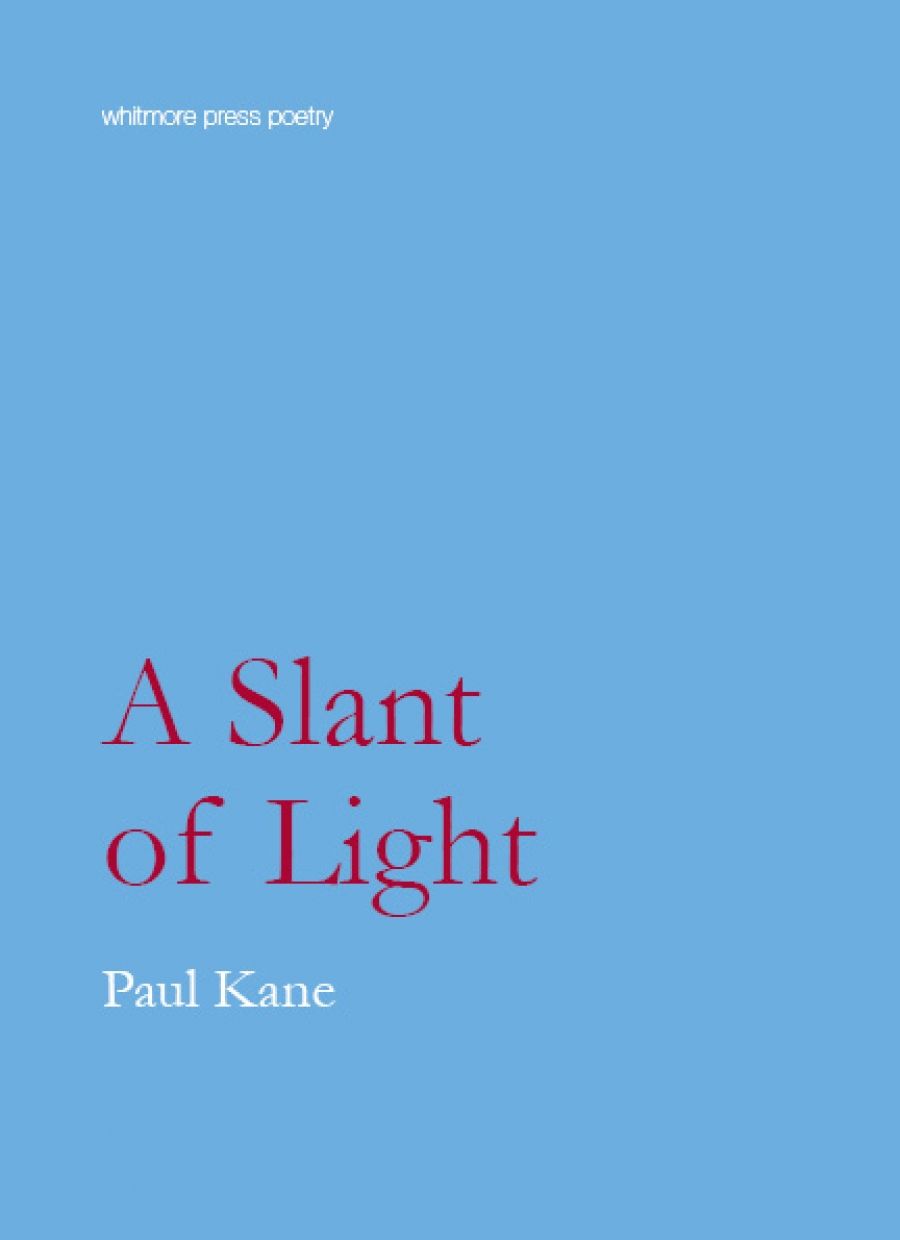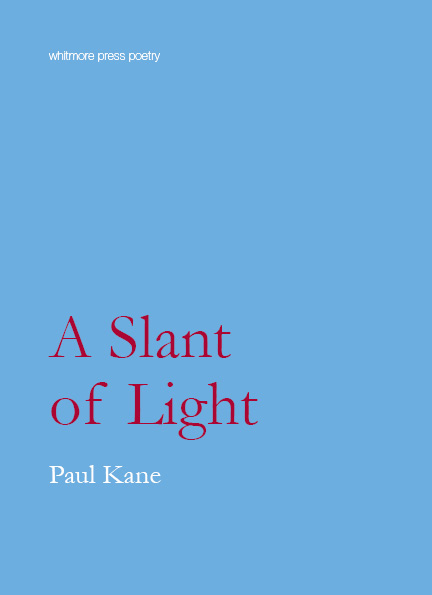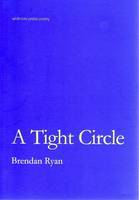
- Free Article: No
- Custom Article Title: Higher visions and dark webs
- Review Article: Yes
- Article Title: Higher visions and dark webs
- Online Only: No
- Custom Highlight Text:
Anthony Lynch, enterprising editor of the notable but short-lived Space magazine, also produces signed, limited-edition chapbooks under the moniker of Whitmore Press. Paul Kane’s A Slant of Light and Brendan Ryan’s A Tight Circle join a list that features Maria Takolander’s Narcissism and Cameron Lowe’s Throwing Stones at the Sun (both 2005).
- Book 1 Title: A Slant of Light
- Book 1 Biblio: Whitmore Press, $16 pb, 32 pp
- Book 1 Cover Small (400 x 600):

- Book 1 Cover (800 x 1200):

- Book 2 Title: A Tight Circle
- Book 2 Biblio: Whitmore Press, $16 pb, 32 pp
- Book 2 Cover Small (400 x 600):

- Book 2 Cover (800 x 1200):

Paul Kane, an American, is known for previous collections such as Work Life (2007) and for his critical writings on Australian poetry and poets. Dividing his time between New York State and Victoria (he teaches at Vassar and is the artistic director of the Mildura Writers’ Festival), Kane offers a unique perspective on all things Australian. A Slant of Light, subtitled Australian Poems, is a new and selected set of twenty-three poems featuring Kane’s responses to Australian poets such as Peter Porter and Phillip Hodgins, and meditations such as ‘Hard Light in the Goldfields’:
That we should exist at all seems unaccountable:
a happy accident, we say – though no one believes
it at heart. Were it not for all our cruelty,
we might live in grace, as hatred is darkness
and darkness the absence of light.
Kane’s penchant for being in two places at once operates on multiple levels, nostalgically in ‘The Grand Tour 1968’, cross-culturally in ‘Two Liners: Dreams Compared’ and contemplatively in his poem for Hodgins:
On the horizon, trees in silhouette
stand distinct and black like shadows thrown
on the wall of a cave behind a parapet.
(‘Dawn at Timor’)
Details such as which type of tree or where in Timor play second fiddle to an empire of signs and reflections from Plato’s cave to Walter Benjamin’s copied souls (‘In the Penal Colony’), the poet road-testing transcendence. Such activities can of course be done at home, and in ‘Black Window’ the wiles of philosophy are brilliantly back on themselves:
In a world of mirrors there is no beyond:
we take ourselves for what we are,
one image imposed upon another
we half believe and half ignore.
Turn again, says the room, but this time
vanish into what you are doing
that you might be seen for what you do
in that other world.
This vanishing represents the ultimate negation, an end to half-belief at the command of the room which connects to ‘that other world’. In his elegies, the focus changes from the vanishings of self to the vanishings of those who have ‘left us your life’ (‘Dear Margie’). A Slant of Light is the better for it, ‘Third Parent’ rounding out the collection:
But we’ll go back, and back, until we find
in the genealogy of the past the source
of a hope born of despair, some hill or field
to call our own, to call to our own: come
and walk with us over the common ground.
Kane’s style is well crafted and assured. By refusing to ‘half believe and half ignore’ his Australian impressions, he has created a series of interior landscapes within the interior (‘Past Cooper Pedy’, ‘Salt level’, ‘On the Murray’), cities (‘South Yarra’) and islands (‘Phillip Island’). Yet, as ‘Black Window’ attests, some of his most stirring poems are set off-road, in silence.
Brendan Ryan’s A Tight Circle takes up where Why I Am Not a Farmer (2002) and A Paddock In His Head (2007) left off, exploring all manner of arrivals and departures before the larger backdrop of the rural–city divide. Ryan is also in two (and more) places at once, but unlike Kane he has recourse to a high degree of specificity, and with it a sense of stark anti-tourism:
Dim light of milk bars
a Streets logo promising summer
traffic stalled on Toorak Road.
The sense of loss, of leaving the city
That used to live inside me.
(‘Driving out of Melbourne’)
In a similar mode to Les Murray’s ‘Thinking About Aboriginal Land Rights I Visit the Farm I Will Not Inherit’ (1974) or Judith Wright’s ‘For a Pastoral Family’ (1985), Ryan laments ‘Like hot tea filled to the brim / I’ve inherited a world / that doesn’t guarantee the present’. While A Tight Circle is painfully aware of family silences, it is also a tribute to family resilience, especially by the women:
Her skin is wrinkled
as a farm in Tyrendarra
his enlistment at lunch
a soldier settlement in Tyrone
a brick veneer in Koroit.
Like entries in a farmer’s diary
her stories shadow Aboriginal history.
She lives between the friends who have died
And cards each fortnight.
(‘Talking to Auntie’)
Now a father himself, Ryan marks the past through a series of changes in others (‘Burying has aged my father / softened his handshake’ [‘A Tight Circle’]). ‘In the park’ draws on Gwen Harwood’s poem of the same name to hold a mirror to the male experience of parks, parenthood and fathers, ‘dutiful, polite, distant / wondering how they landed here’. However, ‘Choppers’, with its saleyard story of ‘skin and bone cows / cast out from the herd’, more faithfully reproduces the bleakness of Harwood’s original, a feat in itself. Cows play a beautifully understated role in A Tight Circle, from the title poem to ‘Winter Morning’, where ‘The paddocks have been eaten down to dirt / Heavily pregnant Friesians regard me with suspicion’. Ryan is a deceptively versatile, uncompromising poet who lives between worlds signified by the contest of often tough facts which in time reveal their own higher visions and dark webs.


Comments powered by CComment